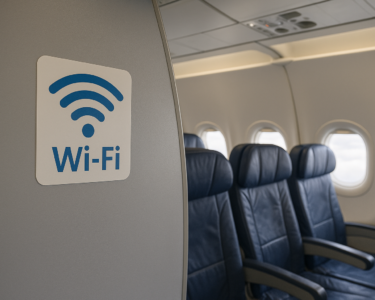In the world of aviation, seamless communication and precise coordination are essential to ensure safety, efficiency, and reliability across flight operations.
One of the cornerstones of this complex ecosystem is ARINC (Aeronautical Radio, Incorporated), a global standard that has shaped the way aviation systems communicate and function together.
Established to address the unique demands of the airline industry, ARINC provides a suite of standards and protocols that have become integral to modern flight operations, facilitating reliable data exchange between aircraft systems, ground control, and other stakeholders.
ARINC standards cover a broad range of applications, from avionics and data networks to navigation systems, supporting airlines, manufacturers, and service providers in implementing systems that adhere to international safety and performance standards.
As aviation technology advances rapidly, understanding the role of ARINC in optimizing flight operations is more important than ever.
This analysis delves into ARINC’s impact on aviation, particularly its influence on communication, safety, and operational efficiency, while also considering its future potential in an industry marked by constant technological evolution.

Key ARINC Standards in Flight Operations
ARINC standards play a foundational role in ensuring interoperability, reliability, and safety within the aviation sector. Different ARINC specifications cater to various elements of flight operations, from avionics communication to data management and networking. Here’s an overview of some of the most impactful ARINC standards in use today:
ARINC 429 – Data Communication in Avionics Systems
ARINC 429 is the primary communication standard used in avionics systems for data transfer between onboard components.
Developed for one-way point-to-point data transmission, ARINC 429 ensures efficient communication between systems like flight controls, navigation, and radar.
This protocol uses a unidirectional data bus, which means information flows from the transmitting unit to the receiving unit without feedback, ideal for applications where signal reliability is crucial. Its simplicity and effectiveness have made it the backbone of aircraft communication.
ARINC 629 – Multi-Transmitter Data Bus
ARINC 629 serves as a multi-transmitter data bus standard, mainly utilized in more advanced aircraft like the Boeing 777. Unlike ARINC 429, ARINC 629 supports a two-way communication protocol, allowing multiple systems to communicate simultaneously over a single bus.
This setup enables higher data rates and efficient integration of various systems, such as flight management and cockpit display systems, while minimizing cabling and reducing weight.
The standard helps to streamline data exchange and improve the integration of complex systems in modern commercial aircraft.
ARINC 653 – Partitioned Operating Systems for Safety-Critical Applications
ARINC 653 is pivotal for systems that demand real-time performance and strict safety protocols. It defines guidelines for partitioning operating systems in safety-critical avionics applications, such as flight management systems, allowing multiple applications to operate on a single processor while maintaining isolation.
This partitioning capability is crucial for systems that handle critical and non-critical processes concurrently, as it ensures that faults in one partition do not affect others, thus enhancing system stability and safety.
ARINC 664 – Aircraft Data Network (ADN) for Ethernet Communication
As aviation moves toward Ethernet-based networking, ARINC 664 has become increasingly important. Known as the Aircraft Data Network (ADN) standard, ARINC 664 defines the guidelines for implementing Ethernet in avionics systems, enabling faster, more reliable data transmission.
This protocol supports data exchange between systems like in-flight entertainment, flight control, and passenger service systems, allowing them to share a common network.
ARINC 664 also supports determinism in data transfer, crucial for real-time communication in safety-critical environments, and has paved the way for highly integrated networked avionics systems in newer aircraft.
The Role of ARINC in Flight Communication and Data Exchange
In aviation, effective communication and rapid, accurate data exchange are essential to ensure safe and efficient flight operations. ARINC standards form the backbone of these processes, enabling reliable communication between various onboard systems, ground control, and external support systems.
By standardizing data protocols, ARINC ensures that all critical information flows seamlessly within and outside the aircraft, supporting real-time decision-making and enhancing situational awareness for both pilots and air traffic controllers. Here’s a look at how ARINC plays a crucial role in these domains:
Reliable Intra-Aircraft Communication
ARINC protocols, such as ARINC 429 and ARINC 664, enable continuous data exchange between different onboard systems, such as navigation, flight controls, engine management, and cockpit displays. By establishing a common language, ARINC ensures compatibility across avionics equipment, even when sourced from multiple manufacturers.
ARINC 429, a unidirectional communication standard, is especially critical for sending reliable, real-time data from sensors to the cockpit display systems, providing pilots with accurate information about altitude, speed, and other flight parameters.
Enhanced Aircraft-to-Ground Communication
ARINC protocols also facilitate efficient communication between the aircraft and ground-based systems, essential for monitoring, tracking, and managing flights.
For example, the ACARS (Aircraft Communications Addressing and Reporting System) protocol—built on ARINC standards—enables real-time messaging between pilots and ground control, allowing for timely updates on weather conditions, flight plan adjustments, and other operational changes.
This capability supports both normal operations and emergency situations by ensuring that ground teams are informed of any in-flight issues and can assist with necessary troubleshooting or rerouting.
Real-Time Data Exchange for Navigation and Safety
ARINC standards play a vital role in navigation by facilitating the continuous transfer of data needed for position tracking and waypoint adjustments.
For instance, ARINC 429 ensures that data from GPS and inertial navigation systems is accurately fed into the flight management system, enabling precise route following and course corrections.
ARINC 664, through Ethernet-based networking, allows for real-time data exchange among systems that rely on up-to-date information, such as collision avoidance, terrain awareness, and weather radar systems.
These systems receive constant updates, which help the flight crew make informed decisions in real time, improving overall safety.
Supporting Data-Intensive Applications and In-Flight Services
ARINC standards, particularly ARINC 664, support high-throughput data applications that enhance the passenger experience and operational efficiency.
By enabling an Ethernet network on board, ARINC 664 allows for robust data flow between various in-flight services, such as entertainment systems, internet connectivity, and passenger communications.
This also includes data exchange for operational insights, where data collected from various aircraft systems is stored or transmitted for post-flight analysis. This information can support predictive maintenance and operational efficiency improvements.
Preventing Communication Delays and Ensuring Data Integrity
ARINC standards are designed to minimize latency in communication and to prioritize data flow for critical systems, ensuring that essential information reaches its destination without delay.
For instance, ARINC 653’s real-time partitioning capabilities allow critical applications to execute independently, ensuring that system updates don’t interfere with essential safety operations.
The standards also emphasize data integrity, with mechanisms to prevent data corruption and errors during transmission. This is crucial in maintaining operational safety, as even minor data discrepancies can have serious implications in aviation.
ARINC and Emerging Technologies in Aviation
As aviation technology continues to evolve, ARINC standards are adapting to accommodate the integration of advanced digital solutions, such as automation, artificial intelligence (AI), and the Internet of Things (IoT).
These technologies are transforming how flight operations are managed, from real-time analytics and predictive maintenance to enhanced safety systems.
ARINC’s role in enabling these innovations is pivotal, as its standards provide the framework needed for seamless data integration, compatibility, and efficient communication. Here’s how ARINC supports the integration of emerging technologies in aviation:

Facilitating the Adoption of AI and Machine Learning in Predictive Maintenance
ARINC standards, such as ARINC 664, which enables high-speed data transmission over Ethernet, provide a solid foundation for data-driven applications.
AI and machine learning algorithms require large volumes of real-time data for accurate predictive maintenance, allowing airlines to identify and address potential issues before they become critical.
By supporting high-throughput data transfer and reliable data storage, ARINC standards enable efficient communication between onboard sensors and ground-based maintenance systems, enhancing operational efficiency and safety while reducing maintenance costs.
Supporting the Internet of Things (IoT) and Sensor Integration
IoT technology in aviation relies on ARINC standards to connect a vast array of sensors throughout an aircraft, from engines to cabin systems.
Standards like ARINC 429 and ARINC 664 ensure that the data collected from these sensors is transmitted accurately and securely to the appropriate systems.
With IoT, airlines can monitor critical metrics in real-time, such as fuel consumption, engine health, and environmental controls, making it easier to optimize flight performance.
The reliable data transmission that ARINC standards provide is essential for this interconnected IoT ecosystem to function effectively.
Advancing Autonomous Flight and UAV Operations
As autonomous flight systems and unmanned aerial vehicles (UAVs) gain traction in both commercial and defense sectors, ARINC standards play an important role in managing the complex data exchange required for autonomous operations.
ARINC 653, for example, provides partitioning capabilities that enable multiple systems to function on a single processor without interference—a crucial feature for safety-critical applications in autonomous flight.
The standardization that ARINC offers helps to create a reliable and predictable framework for developing autonomous flight systems, allowing these technologies to evolve within the existing aviation infrastructure.
Enabling Enhanced Cybersecurity Measures
With the rise of digital systems and IoT, cybersecurity has become a top priority for the aviation industry. ARINC standards, particularly ARINC 664, incorporate security protocols that help protect the integrity of data exchanged across the network.
ARINC’s rigorous standards help prevent unauthorized access and data breaches by defining strict data-handling rules, ensuring that sensitive information, such as aircraft positioning, performance data, and passenger information, remains secure. This is crucial for preventing cyber threats, which are increasingly targeting aviation infrastructure.
Adapting to Next-Generation Aircraft with Ethernet-Based Networking
Modern aircraft are becoming highly digitized, relying on sophisticated data networks to manage everything from cockpit controls to passenger entertainment.
ARINC 664 supports Ethernet-based communication, enabling high-bandwidth data transfer that is crucial for next-generation aircraft.
This Ethernet backbone allows for faster communication speeds and more extensive system integration, facilitating real-time data exchange for advanced applications, such as augmented reality-based navigation aids and in-flight system diagnostics.
This networking capability also allows next-generation aircraft to easily integrate with ground-based systems and external data sources, further enhancing operational efficiency.
Enhancing Real-Time Analytics and Operational Insights
Real-time data analytics, driven by ARINC-enabled networks, is transforming flight operations. Airlines can now collect and analyze data from various sources—such as fuel levels, weather conditions, and flight paths—while the aircraft is still in flight.
This data flow, supported by ARINC standards, provides ground control teams with insights that enhance decision-making in real-time.
ARINC 429 and 664 standards ensure that data from critical systems is relayed to the cockpit and ground teams without delays, allowing for faster adjustments to routes, fuel usage, or maintenance needs based on real-time conditions.
Conclusion
ARINC standards are at the heart of aviation’s technological advancements, providing a robust framework that supports safe, efficient, and interconnected flight operations.
From enabling reliable data exchange in traditional flight systems to facilitating the integration of emerging technologies like AI, IoT, and autonomous flight, ARINC continues to play a vital role in shaping modern aviation.
As the industry moves toward a future with even more digitalization, smart analytics, and enhanced passenger experiences, ARINC’s adaptable standards will ensure that these innovations meet strict safety, interoperability, and performance criteria.
By standardizing data protocols across avionics systems and networks, ARINC not only ensures consistent and reliable communication but also supports the secure adoption of new technologies that promise to enhance operational efficiency and safety.
Looking forward, as aviation explores electric and hybrid aircraft, urban air mobility, and other groundbreaking developments, ARINC will remain essential, offering the stability and adaptability needed for the industry to grow safely and sustainably.
Through continuous evolution, ARINC standards will continue to bridge the gap between legacy systems and cutting-edge technology, empowering the aviation sector to embrace innovation without compromising safety or reliability.







